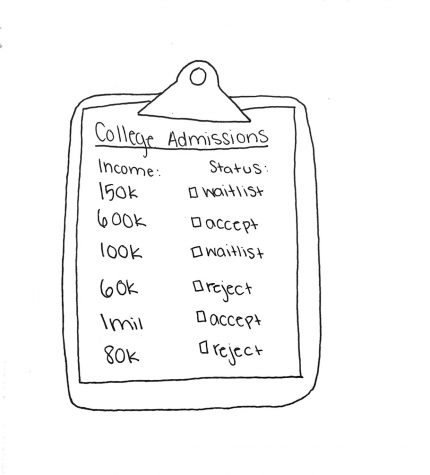Money over Merit: College admissions favor the rich
May 21, 2021
As May 1st, college commitment day, approaches many high school seniors are pressed with nerves as college decisions become finalized. For some, this means getting into their dream university while, for others, it means that their hard work was not enough to get into the college of their choice. Don’t worry, your college decisions may have far less to do with your academics, extracurriculars or athletics and may rely on something else –– money. While colleges claim to recognize the financial situations that some students are in, the college admissions process is still riddled with classism.
One especially discriminating factor that is considered during the college admissions process is legacy status. A legacy is an applicant who is regarded preferentially at a university because a relative is an alumni. Legacy children are usually more financially stable since their parents hold a college degree; people with a four-year college degree make on average 30 thousand dollars a year more than people with a high school diploma. According to a Cub-Bark survey, 70.1 percent of Redwood students have at least one parent who has graduated from a private university, making them a legacy.
Natasha Warikoo, a sociology professor at Tufts University, finds that preference in admissions offers a boost to applicants who are already financially privileged, often at the expense of equally talented students who are less financially privileged.
While this piece of information may seem minor compared to the dozens of other information applicants provide on their college application, according to The Atlantic, being a legacy can double your chances of getting into the college of your choice. Furthermore, according to The Wall Street Journal, this number is even higher for some elite schools; statistics show that Harvard legacy applicants were five times more likely to be accepted compared to other applicants. The reason for this is money. Colleges often predict that alumni will donate money to the college they graduated from if their child attends the institution as well, making them more likely to accept their children.
 Moreover, the cost of attending college is often unattainable for many candidates, and financial aid has failed low-income applicants for years. Only 17% of families can afford the average college tuition without financial assistance, according to ThinkAdvisor, a publication that reports on finances. CNBC reports that those enrolled at four-year, public institutions paid an average of $3,190 in tuition in the 1988 school year; that average has risen to $9,970 for the 2018 school year, a 213 percent increase accounting for inflation. To alleviate some of this financial pressure, students are recommended to take out student loans; however, this leaves students drowning in debt. The American population combined holds 1.71 trillion dollars worth of student loan debt, according to Student Loan Hero, an organization dedicated to helping students pay off their loans.
Moreover, the cost of attending college is often unattainable for many candidates, and financial aid has failed low-income applicants for years. Only 17% of families can afford the average college tuition without financial assistance, according to ThinkAdvisor, a publication that reports on finances. CNBC reports that those enrolled at four-year, public institutions paid an average of $3,190 in tuition in the 1988 school year; that average has risen to $9,970 for the 2018 school year, a 213 percent increase accounting for inflation. To alleviate some of this financial pressure, students are recommended to take out student loans; however, this leaves students drowning in debt. The American population combined holds 1.71 trillion dollars worth of student loan debt, according to Student Loan Hero, an organization dedicated to helping students pay off their loans.
According to a study done by the Student Debt Crisis Organization, 65 percent of student loan borrowers spend more on their student loan debt than food a month, 30 percent of borrowers spend more on their student loans than on health insurance a month, and 30 percent spend more on their student loans than monthly rent.
The New York Times recently investigated the wealth divide at top colleges and found that elite universities have more students from the top one percent of the wealthy than from the bottom 60 percent. These statistics do not mean that students coming from lower socioeconomic backgrounds can not get into college; they simply show that it is significantly harder for them compared to their wealthier counterparts.
This deeply integrated classism in the college admissions system cannot be changed overnight; however, student loan forgiveness programs are great ways to make federal headway on this issue. College admissions officers should take into account the impact that lower socioeconomic status has on students’ ability to compete with the richer applicants, and universities should attempt to include socioeconomic diversity into their institution.
For the Redwood college applicants who are worried because they are not a legacy, do not think they can afford college or are not in the one percent, there is hope. As this problem gains more media exposure and people are speaking out on its issues, more and more programs are dedicated to reducing the financial burden on college attendees, and hopefully, the elite colleges will recognize the problematic nature of legacy status sooner rather than later.























